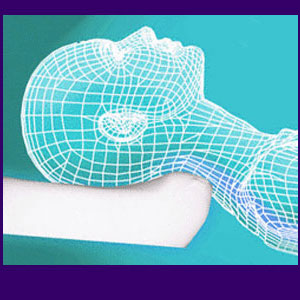
Tension myositis syndrome in the neck is the second most prevalent symptomatic location for this psychologically-motivated pain syndrome to strike. TMS neck pain is very common, with only TMS lower back pain edging it out in the number of patients affected with chronic mindbody symptoms.
Neck pain can be just as debilitating as any other dorsalgia condition and also has an inherently high fear factor, since the neck is in close proximity to the brain and contains the upper spinal cord. Therefore, conditions which affect the neck sometimes raise the specter of paralysis or spinal cord damage. Since TMS thrives on fear and misinformation, it is no surprise that the neck represents an ideal target for symptoms to reside. Neck pain due to TMS is almost always misdiagnosed as stemming from some structural source; typically a herniated disc or spinal arthritis process in the cervical spine.
Most patients do not know they have TMS until they suffer through numerous failed treatments and decide to pursue alternative therapy options out of sheer desperation. This is the saddest fact about TMS treatment, in general.
This article examines TMS in the neck, including the causes, symptoms, treatments and personal experiences of this rampant health crisis.
Causes and Symptoms of TMS in the Neck
TMS is always enacted through a mindbody process that is driven by emotional imperatives. Typically, the actual causation of symptoms relies on the process of ischemia, which is a condition of oxygen deprivation that is deliberately executed by the mind and perpetrated against the body.
Lack of oxygen in the neck can cause pain in the neurological tissues, as well as nerve dysfunction. Continued lack of oxygenation will also affect the muscles and other soft tissues, causing widespread symptomology.
Since the ischemic process can directly or indirectly target the spinal cord and spinal nerves, symptoms may spread virtually anywhere in the body, since all lower anatomical regions are eventually innervated by the central nervous system components that reside in the cervical spine.
No one knows exactly why some people develop troublesome tension myositis in the neck and others do not, but many specialists feel that TMS is actually a universal human phenomenon, with the only differences between patients being the location of their symptoms, the severity of their symptoms, the duration of their symptoms, the mechanism responsible for their symptoms and the underlying emotions that generate the symptom imperative. In essence, TMS might describe an inherent part of the human condition, which is why psychosomatic health expressions are considered normal and expected throughout life.
Treatment for Tension Myositis Syndrome in the Neck
TMS theory acknowledges the usual degenerative structural changes in the spine as being mostly normal and asymptomatic. Accepted medical research supports this conclusion, since little, if any, evidence exists correlating most spinal abnormalities to the incidence of chronic neck pain.
TMS is a true mindbody disorder, with the pain existing 100% in the body, while the source mechanism exists 100% in the subconscious mind. For patients who can not fathom this concept, recovery is impossible, since the crucial consideration of curing TMS resides in understanding the condition and dispelling the influence of any anatomical reasons previously blamed for enacting the painful neck symptoms.
Dr. John E. Sarno has worked diligently to spread the word about his TMS diagnosis and has actively treated tens of thousands of patients in person and millions of patients via his popular books.
For patients who are lucky enough to realize that TMS is the true causation behind their suffering, the curative process is rather simple. However, the use of knowledge therapy materials and practices is not universally effective and some patients seem resigned to pain regardless of their attempts to enact a cure. That being said, millions of people do successfully overcome tension myositis syndrome, and a host of other mindbody disorders, using the risk-free, cost-free and constructive tactics associated with knowledge therapy treatment.
Experiences with Tension Myositis Syndrome in the Neck
Neck pain is often felt in combination with many other TMS symptoms. These psychologically-induced pain syndromes may include anxiety, dizziness, headaches, trigeminal neuralgia, TMD, shoulder pain and a variety of upper body neurological symptoms.
TMS in the neck is known to be a fantastically effective primary symptomatic location, often using secondary expressions to further its goals. There are many health issues that are known to be part of the TMS arsenal and many patients endure multiple tension myositis expressions concurrently or cyclically.
However, tension myositis syndrome in the neck might also be a secondary location, usually in relation to a primary lower back symptom set. This describes my own case of symptoms, which resided in the lumbosacral region for decades, until they migrated north to the neck, as well.
To learn more about TMS in the neck, back, or anywhere, we highly recommend reading Dr. Sarno’s original works on the subject. Although much time has passed since these were authored, the books are still the definitive guides to the condition and continue to help patients find relief, decades later. However, there are many other sources of knowledge therapy. Since most of these volumes can be found at a local library, or ordered for a very inexpensive price, we recommend reading as many as possible, since each work appeals to a particular audience and might just be the one to provide true insight towards your own lasting cure.
Back Pain > Tension Myositis Syndrome > Tension Myositis Syndrome in the Neck





